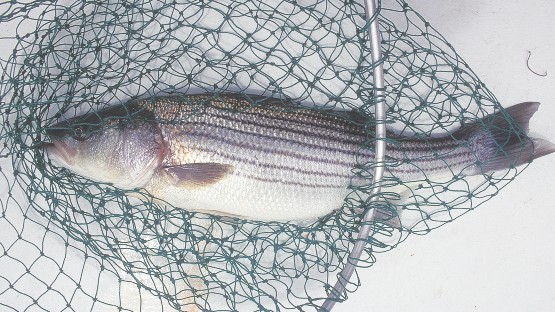
Spurred by a warning about increased fishing pressure on already overfished Atlantic striped bass, East Coast fishery managers took emergency action this week to curtail the recreational catch of the popular species while preparing for potentially more restrictions next year.
The Atlantic States Marine Fisheries Commission, which regulates inshore catches of migratory fish, heard from a panel of scientists that the recreational catch of striped bass had doubled in 2022 over what it had been the year before, despite catch limits imposed to protect the diminished population.
Unless action was taken to reduce that catch, the expert panel said, the chances of rebuilding the striped bass stock by the end of the decade, as the commission had committed previously to doing, would fall from nearly 80% to under 15%.
In response, the commission’s striped bass management board voted unanimously May 2 to draw up a menu of potential new restrictions on recreational and possibly commercial fishing for striped bass. The new limits are expected to be adopted later this year and take effect in 2024.
But, feeling prompt action was urgently needed to protect spawning-age fish, the board also voted 15 to 1 to impose emergency limits. It ordered all East Coast states to adopt a 31-inch limit for 180 days on the size of hooked striped bass that anglers could keep. The limit is to be applied as soon as possible but no later than July 2. After Oct. 28, the board can either end or extend the size limit for up to two more years.
“We really felt we should try to get ahead of this as soon as we could,” said Martin Gary, chair of the management board, who is also executive secretary of the Potomac River Fisheries Commission.
Striped bass, also known as rockfish, are one of the most sought-after sport and commercial fish in the Chesapeake Bay and along the mid-Atlantic coast. But anglers have been under tighter rules for catching them the last few years after scientists warned that they were being overfished and that numbers of adult female fish had fallen below what is needed to sustain the population.
Catch-and-release fishing by anglers is killing a significant number of striped bass, scientists said, especially in summer when warm water temperatures and lower oxygen levels further stress fish that are caught and handled. The Atlantic states commission responded in 2020 by ordering an 18% reduction in fishing-related mortality coastwide. It directed states to limit all anglers to one fish per day and set uniform size limits for keeping fish caught along the Atlantic coast and in the Bay, which is a major spawning and nursery ground for the migratory species. States were allowed to deviate from the coastwide limits if their rules reduced overall fish losses by the same amount.
Those restrictions seemed to work at first. The estimated mortality in 2021 of striped bass coastwide dropped by 28%, surpassing the commission’s goal for rebuilding the stock by 2029. But angler surveys conducted in 2022 tallied a doubling of the recreational catch from the previous year, raising fresh concerns about prospects for rebuilding the population.
Some have questioned the accuracy of those surveys. But Gary, the striped bass board chair, said the consistency and sheer size of the increase was too great to discount. Plus, he added, it matched anecdotal observations by anglers and fishery managers alike of increased fishing activity in 2022.
The commission has only taken emergency action to curb fishing four prior times, said Gary. The decision to do so in this case was motivated largely by a recognition that the last bumper crop of striped bass, spawned in 2015, are now big enough to be legally caught along the coast.
“Another year of fishing on them like we did last year could have been really bad,” said Mike Luisi, assistant fisheries director for Maryland’s Department of Natural Resources.
Reproduction has been poor for the last four years, meaning fewer fish are likely to reach maturity in coming years to help maintain the species.
The 31-inch limit will have various effects, depending on the season and jurisdiction. It will have the greatest impact on anglers fishing along the Atlantic coast, because the striped bass roaming there tend to be larger than those in the Bay. Those who fish in the ocean were already required to release any fish smaller than 28 inches or larger than 36 inches. Under the emergency rule, they’ll only be able to keep those striped bass within a 3-inch size range.
But Gary said that restriction seemed fitting, because the survey data indicated the biggest increase in recreational catch last year occurred in ocean waters from Cape Cod, MA, to Cape May, NJ.
Because the public had no opportunity to comment on the new size limit before it was imposed, the commission will hold at least four virtual public hearings in mid- to late May to explain the reasons for it and spell out their plans for considering additional restrictions later this year, which could be applied in 2024.
The commission’s action drew praise from conservation and sports angling groups.
“It’s definitely a step in the right direction,” said Allison Colden, a fisheries scientist who is Maryland director of the Chesapeake Bay Foundation. With striped bass reproduction faltering in recent years, she noted, it’s prudent to act now to protect the last bumper crop in 2015.
“Hopefully, it will prevent the need for more severe actions [later],” she said.
David Sikorski, executive director of Coastal Conservation Association Maryland, said the board’s move to adjust fishing rules starting in 2024 was “pro-active,” because managers chose not to wait for a new scientific assessment of the striped bass population, which isn’t expected until fall of 2024.
He likewise supported the emergency size limit. “Any of these larger fish we can protect, the better off we are,” he said.
The Maryland DNR plans to impose the 31-inch size limit by May 16 via a public notice, said Luisi. Until now, there has been no maximum size in Maryland waters. The state’s summer-fall Bay rockfish season runs from May 16 through July 15 and from Aug. 1 through Dec. 10. During those times, anglers can keep one fish per day of at least 19 inches in length. Those on chartered fishing boats may keep two fish per day per person if they report their catch electronically.
Luisi said he did not expect the maximum size limit to affect Bay fishing that much because the large fish migrate to the ocean after spring and most that remain in the Chesapeake are smaller than 31 inches.
The emergency size limit might have upset the state’s spring trophy season, which began Monday and runs through May 15. During those two weeks, anglers in the Bay can catch one fish a day at least 35 inches long. But Luisi said it was too late to change that, so the commission agreed to exempt it.
In Virginia, the 31-inch limit must be enacted by regulation, which can take weeks to do. Pat Geer, fisheries chief for the Virginia Marine Resources Commission said “we will try our best” to have it in effect by July 2, the deadline set by the Atlantic States commission. But Virginia’s spring rockfish season, which runs from May 16 through June 15, already has a size limit of 19 to 28 inches. No stripers may be kept in the Virginia portion of the Bay from June 16 to Oct. 3. The new maximum size will affect fall fishing, which goes from Oct. 4 through Dec. 31. Rules in place now would allow keeping one fish per day, ranging in size from 20 to 36 inches.
Fishing in the Potomac River also could be affected. The summer-fall season there lasts from May 16 through July 6 and then from Aug. 21 through Dec. 31. Anglers may keep two fish a day of at least 20 inches, with no maximum now. Gary, the Potomac River Fisheries Commission’s executive secretary, said its members could impose the 31-inch limit on or before the July 2 deadline set by the Atlantic States commission.
Tim Wheeler is the Bay Journal’s associate editor and senior writer, based in Maryland. You can reach him at 410-409-3469 or [email protected]. This article was first published May 5, 2023, on Bayjournal.com and was distributed by the Bay Journal News Service.










